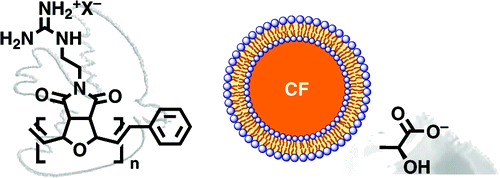- Hennig, A.; Gabriel, G.; Tew, G.; Matile, S. “Stimuli-Responsive Polyguanidino-Oxanorbornene Membrane Transporters as Multicomponent Sensors in Complex Matrices” J. Am. Chem. Soc. 2008, 130, 10338-10344

We introduce guanidinium-containing synthetic polymers based on polyguanidino-oxanorbornenes (PGONs) as anion transporters in lipid bilayers that can be activated and inactivated by chemical stimulation. According to fluorogenic anion export experiments with vesicles, PGON transporters are most active in neutral bilayers near their phase transition, with EC50’s in the nanomolar range. Six times higher effective transporter concentrations were measured with aminonaphthalene-1,3,6-trisulfonate than with 5(6)-carboxyfluorescein, demonstrating the importance of anion binding for transport and excluding nonspecific efflux. Negative surface potentials efficiently annihilate transport activity, while inside-negative membrane potentials slightly increase it. These trends demonstrate the functional importance of counterions to hinder the binding of hydrophilic counterions and to minimize the global positive charge of the transporter−counterion complexes. Strong, nonlinear increases in activity with polymer length reveal a significant polymer effect. Overall, the characteristics of PGONs do not match those of similar systems (for example, polyarginine) and hint toward an interesting mode of action, clearly different from nonspecific leakage caused by detergents. The activity of PGONs increases in the presence of amphiphilic anions such as pyrenebutyrate (EC50 = 70 μM), while several other amphiphilic anions tested were inactive. PGONs are efficiently inactivated by numerous hydrophilic anions including ATP (IC50 = 150 μM), ADP (IC50 = 460 μM), heparin (IC50= 1.0 μM), phytate (IC50 = 0.4 μM), and CB hydrazide (IC50 = 26 μM). The compatibility of this broad responsiveness with multicomponent sensing in complex matrices is discussed and illustrated with lactate sensing in sour milk. The PGON lactate sensor operates together with lactate oxidase as a specific signal generator and CB hydrazide as an amplifier for covalent capture of the pyruvate product as CB hydrazone (IC50 = 1.5 μM).
DOI: 10.1021/ja802587j
open archive unige:5668 • pdf ![]()
